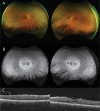Unraveling mucolipidosis type III gamma through whole genome sequencing in late-onset retinitis pigmentosa: a case report
- PMID: 37752499
- PMCID: PMC10523780
- DOI: 10.1186/s12886-023-03136-4
Unraveling mucolipidosis type III gamma through whole genome sequencing in late-onset retinitis pigmentosa: a case report
Abstract
Background: We describe the case of a 47-year-old man referred to a retinal clinic and diagnosed with late-onset retinitis pigmentosa. Surprisingly, genetic testing revealed compound heterozygous pathogenic variants in GNPTG, leading to the diagnosis of the autosomal recessive lysosomal storage disorder mucolipidosis type III gamma. Mucolipidosis type III gamma is typically diagnosed during childhood due to symptoms relating to skeletal dysplasia. Retinal dystrophy is not a common phenotypic feature.
Case presentation: Ophthalmologic examination was consistent with a mild form of retinitis pigmentosa and included fundus photography, measurement of best-corrected visual acuity, optical coherence tomography, electroretinogram and visual field testing. Extraocular findings included joint restriction and pains from an early age leading to bilateral hip replacement by age 30, aortic insufficiency, and hypertension. Genetic analysis was performed by whole genome sequencing filtered for a gene panel of 325 genes associated with retinal disease. Two compound heterozygous pathogenic variants were identified in GNPTG, c.347_349del and c.607dup. The diagnosis of mucolipidosis type III gamma was confirmed biochemically by measurement of increased activities of specific lysosomal enzymes in plasma.
Conclusion: To our knowledge this is the first description of retinitis pigmentosa caused by compound heterozygous variants in GNPTG, providing further indications that late-onset retinal dystrophy is part of the phenotypic spectrum of mucolipidosis type III gamma.
Keywords: Case report; GNPTG; Inherited retinal dystrophy; Lysosomal disease; Mucolipidosis type III gamma; Retinitis pigmentosa; Whole genome sequencing.
© 2023. The Author(s).
Conflict of interest statement
KDG: None. KM: None. KN: None. ES: Receiver of research grant from Alnylam Pharmaceuticals Inc. AL: Member of the European Reference Network on Rare Congenital Malformations and Rare Intellectual Disability ERN-ITHACA [EU Framework Partnership Agreement ID: 3HP-HP-FPA ERN-01-2016/739516]. EB: Receiver of research grant from Novartis Sverige AB.
Figures


Similar articles
-
Identification of predominant GNPTAB gene mutations in Eastern Chinese patients with mucolipidosis II/III and a prenatal diagnosis of mucolipidosis II.Acta Pharmacol Sin. 2019 Feb;40(2):279-287. doi: 10.1038/s41401-018-0023-9. Epub 2018 Jun 5. Acta Pharmacol Sin. 2019. PMID: 29872134 Free PMC article.
-
Three novel homozygous mutations in the GNPTG gene that cause mucolipidosis type III gamma.Gene. 2014 Feb 10;535(2):294-8. doi: 10.1016/j.gene.2013.11.010. Epub 2013 Dec 6. Gene. 2014. PMID: 24316125
-
The lysosomal storage disorders mucolipidosis type II, type III alpha/beta, and type III gamma: Update on GNPTAB and GNPTG mutations.Hum Mutat. 2019 Jul;40(7):842-864. doi: 10.1002/humu.23748. Epub 2019 Apr 13. Hum Mutat. 2019. PMID: 30882951
-
[Clinical and genetic analysis of mucolipidosis in 3 pedigrees and literature review].Zhonghua Er Ke Za Zhi. 2019 Dec 2;57(12):950-954. doi: 10.3760/cma.j.issn.0578-1310.2019.12.010. Zhonghua Er Ke Za Zhi. 2019. PMID: 31795562 Review. Chinese.
-
Mucolipidosis type II and type III: a systematic review of 843 published cases.Genet Med. 2021 Nov;23(11):2047-2056. doi: 10.1038/s41436-021-01244-4. Epub 2021 Jun 25. Genet Med. 2021. PMID: 34172897
References
-
- Di Lorenzo G, Velho RV, Winter D, Thelen M, Ahmadi S, Schweizer M, et al. Lysosomal proteome and Secretome Analysis identifies Missorted enzymes and their nondegraded substrates in mucolipidosis III mouse cells. Mol Cell Proteomics. 2018;17(8):1612–26. doi: 10.1074/mcp.RA118.000720. - DOI - PMC - PubMed
-
- Varki AP, Reitman ML, Kornfeld S. Identification of a variant of mucolipidosis III (pseudo-hurler polydystrophy): a catalytically active N-acetylglucosaminylphosphotransferase that fails to phosphorylate lysosomal enzymes. Proc Natl Acad Sci USA. 1981;78(12):7773–7. doi: 10.1073/pnas.78.12.7773. - DOI - PMC - PubMed
Publication types
MeSH terms
Substances
Supplementary concepts
LinkOut - more resources
Full Text Sources
Miscellaneous

